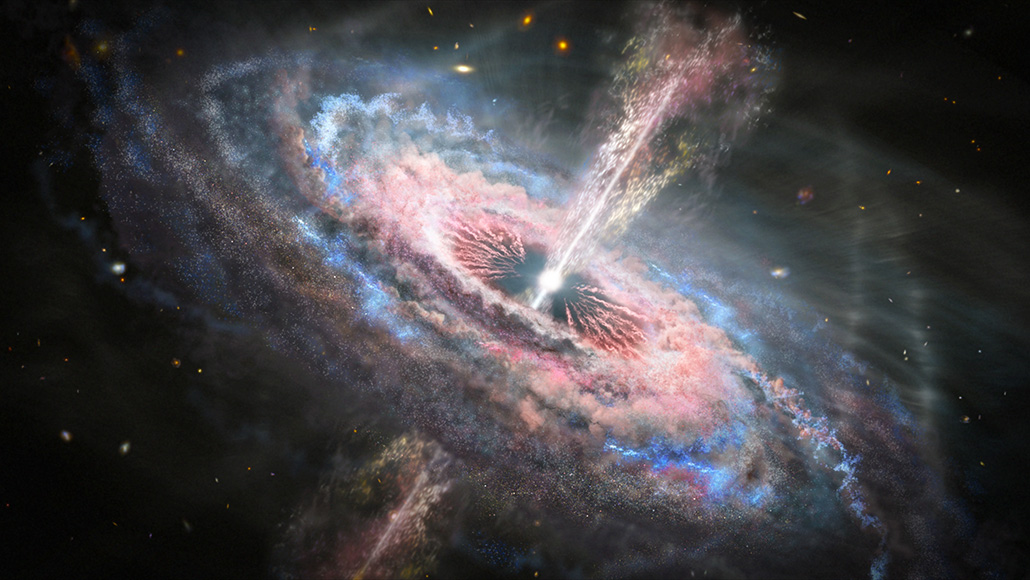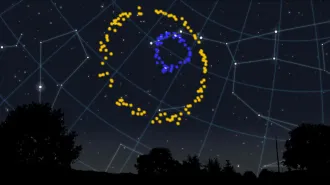
Bright, active black holes at the centers of galaxies, called quasars (illustrated), can blow gas out into space, shutting down galactic growth.
J. Olmsted/STScI, ESA, NASA
- More than 2 years ago
Black holes in the distant universe blow winds with 100 times the energy of all the stars in the Milky Way combined. These great gusts, called quasar outflows, carry enough material away from their home galaxies to eventually shut down those galaxies’ star formation, astronomers report in six papers published March 16 in the Astronomical Journal Supplement Series.
“We found the three largest, most energetic outflows anyone has ever found,” says astronomer Nahum Arav of Virginia Tech in Blacksburg. “At that size, they’re a serious influencer for the evolution of the galaxy.”
Arav and his colleagues used the Hubble Space Telescope to measure the masses, speeds and energies of outflows from 10 quasars, active supermassive black holes in the hearts of distant galaxies that can outshine the galaxies themselves (SN: 12/5/18).
The observations, made over about 60 hours in 2017, mark the first dedicated survey of quasar outflows. Astronomers can’t see the gas directly. But as quasar light filters through the gas, atoms and ions absorb specific wavelengths of light, revealing the outflows’ properties.
Illustrations often show these outflows as twin jets streaming from the black hole perpendicular to the galaxy’s disk of stars. But the gas probably flows out in all directions, Arav says, and spreads like the surface of an expanding balloon. Astronomers are unclear on exactly how the outflows are produced, but the gas may be emitted in periodic outbursts over time.
Theories of how galaxies evolve suggested that outflows could propel gas and dust away from the galactic center, enriching the material between galaxies with elements heavier than hydrogen and helium (SN: 7/12/18) and shutting off star formation (SN: 2/11/20). Such galactic shutdowns could explain why we see fewer big galaxies in the modern universe than supercomputer simulations have suggested should be there.
“Theorists could show very easily, with back-of-the-envelope physics, that if the outflows have enough energy,” they will shut down the galaxy’s star formation, Arav says. But previous observations of distant galaxies, made with ground-based telescopes, found outflow energies that were too low for that.
Hubble revealed light from the quasars in the far ultraviolet wavelength range, which turns out to be where most of the matter in the outflows can be seen. The team found that each of the 10 quasars has three outflows, on average, which surround the black hole like nesting dolls.
The outflows are mostly found between 300 and 3,000 light-years from the central black hole, which means they extend far enough to have a big influence on the galaxy, Arav says. And about half of the outflows measured were energetic enough affect their galaxies’ fates.
“It’s good to see that [quasar outflows are] important” for galactic evolution, says astronomer Jane Charlton of Penn State, who was not involved in the new research. She had started to wonder if quasars alone would be enough, or if some unknown galactic process was needed. “This work is saying that it is probably enough.”
The most energetic outflow came from a quasar called SDSS J1042+1646 with 5×1030 gigawatts, or 5 million trillion trillion gigawatts. For perspective, a nuclear reactor puts out about one gigawatt of energy, while the total energy of all Milky Way stars is about 1028 gigawatts.
The team also found an outflow with the largest acceleration ever seen from the same quasar. In 2011, the outflow was moving at about 19,500 kilometers per second. But when the team looked again in 2017, the gas was racing at 21,050 kilometers per second, 1,550 kilometers per second or about 8 percent faster, says astronomer Xinfeng Xu, also of Virginia Tech. At the faster speed, the flow could travel from London to Washington, D.C., in about a quarter of a second. Previously, astronomers had seen velocity shifts in only a few outflows, and the differences were at most 900 kilometers per second over three to five years.
“These papers give us fundamental information on what quasars are actually doing in blowing matter out” — specifically the speeds, energies and accelerations of the gas, says theoretical astrophysicist Jeremiah Ostriker of Columbia University. “It’s basic information which we’re going to have to understand if we’re going to understand the evolution of galaxies and the evolution of black holes.”







